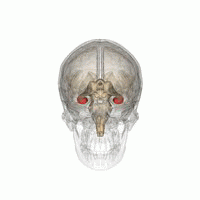
Photo from wikipedia
The function of sleep in memory consolidation has been well established. Hippocampal CA1 and CA3 subregions are thought to be particularly important in this process. The current working hypothesis postulates… Click to show full abstract
The function of sleep in memory consolidation has been well established. Hippocampal CA1 and CA3 subregions are thought to be particularly important in this process. The current working hypothesis postulates that episodic memory traces captured during waking hours are replayed in the hippocampal CA1-CA3 areas and transferred to the cortex for long-term storage during sleep. Even though the sensory and spatial information from higher-order cortical areas such as the entorhinal cortex primarily enters the hippocampus via the dentate gyrus (DG), this structure has always been considered as the “silent partner” in memory consolidation. Whether and how the captured memory traces are transferred from the DG toward the downstream hippocampal areas is less known. Here, we used fiber photometry, two-photon calcium imaging, and EEG recording to examine the activity of DG during sleep. Strikingly, we found that DG cells are even more active during sleep than wakefulness and the calcium activity in the DG slowly oscillates during non-REM (NREM) sleep epochs. Furthermore, we also found that the cycles of this activity coinciding with microarousals are tightly locked to brief serotonin (5-HT) release during NREM sleep. Pharmacological blockade of 5-HT1a receptors abolished the calcium oscillations in the DG. Furthermore, genetic knockdown of 5-HT1a receptors in the DG leads to memory impairment in spatial and contextual memory tasks. Together, our results indicate that ultra-slow calcium oscillations in the DG during NREM sleep are driven by serotonin fluctuations and they are required for memory consolidation.
Journal Title: SLEEP
Year Published: 2023
Link to full text (if available)
Share on Social Media: Sign Up to like & get
recommendations!